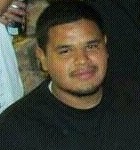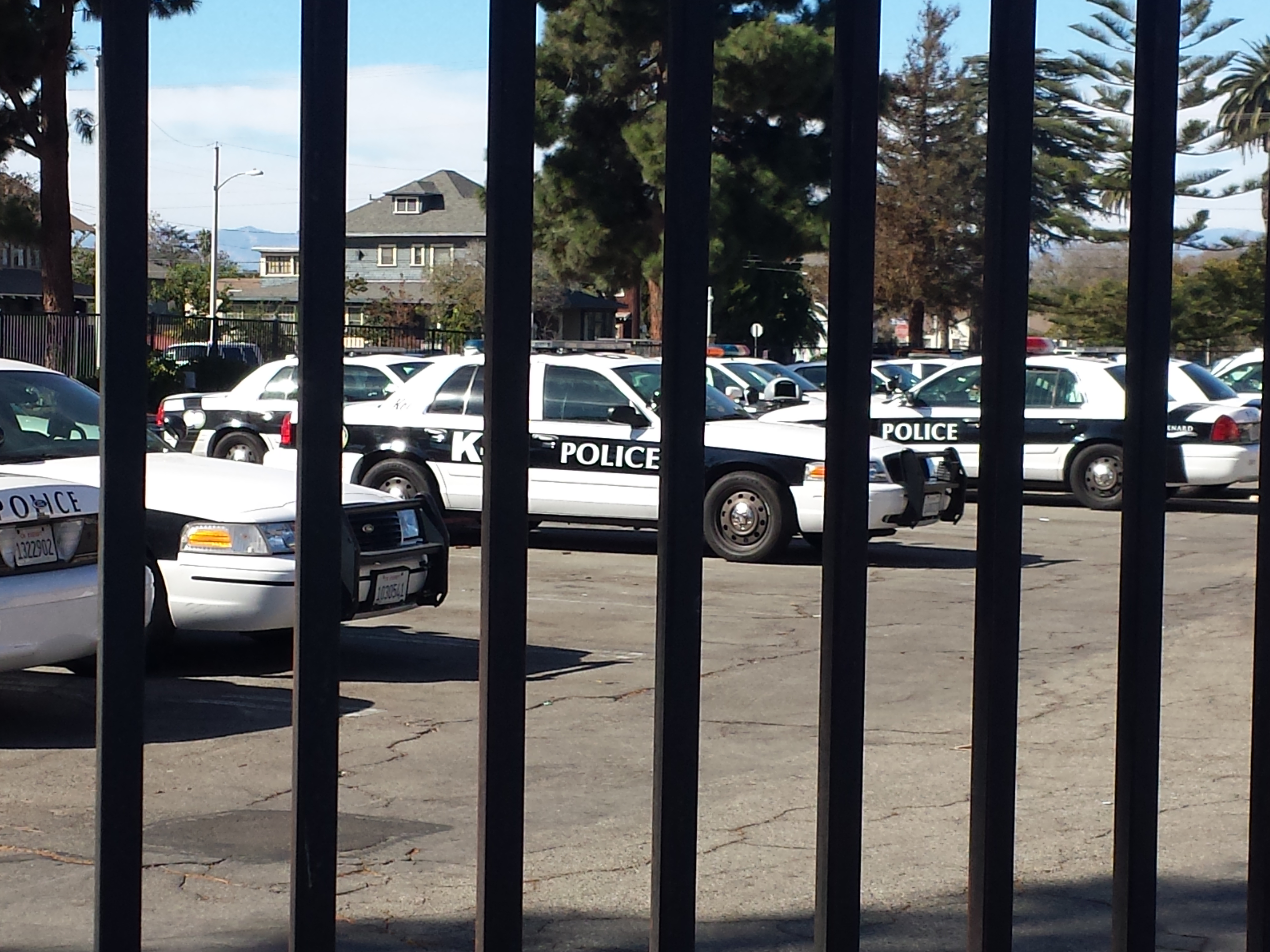BY RAUL HERNANDEZ
American Justice Notebook Reporter
OXNARD, CALIFORNIA — The jaywalking case – the People vs. Francisco Romero – has lingered in the Ventura County courts for a year.
The court hearings have resulted in a lot of legal haggling, a slew of judges making rulings on the matter and several prosecutors assigned to handle the legal proceedings.
Romero said he expects the case to end up at the California Supreme Court if he is found guilty of jaywalking.
The case is more than just someone getting a ticket for crossing the street unlawfully and without regard for approaching traffic. It has become symptomatic of the growing animosity, finger pointing, accusations and counter accusations between the Oxnard Police Department and members of Todo Poder al Pueblo Collective surrounding allegations of police brutality, abuse and fatal shootings.

The city, which has more than 200,000 residents, has been divided between residents who side with Pueblo Collective that is calling for a citizens’ Police Oversight Committee and others who are siding with Police Chief Jeri Williams who is against creating an Oversight Committee.
The recent hiring of a San Francisco law firm to investigate allegations that some officers put shooting-tattoos on their left shoulders that are “earned” by being in a shooting with suspects has added more fuel to the acrimonious atmosphere that has made its way to the City Council Chambers.
Romero’s case began when he received a letter dated Oct. 29, 2013 from the Oxnard Police Department. Romero, a community activist and one of the leaders of the Pueblo Collective, learned that he had been given five jaywalking citations. The five violations were video recorded by an undercover Oxnard police officer in a vehicle who was assigned to monitor the Oct. 13, 2013 protest.
“I was shocked,” said Romero. “It was definitely a retaliatory move.”
The march was held to protest the fatal shooting by police of Alfonso Limon Jr., a year earlier on Oct. 12, 2012.

Limon, a 21-year-old, and his younger brother, Gerardo, were walking home in La Colonia, a predominately low-income, Hispanic neighborhood in Oxnard, when they got caught up in a running gun battle between police and a wanted parolee in October 2012.
Romero said police and prosecutors are sending a message that is crystal clear:”If you become a leader and organizer, this is what is going to happen.”
Officer Brown stated in a certified letter dated Oct. 29 that Romero was being issued five jaywalking citations and he had been seen by police “organizing and leading an un-permitted march.”
“Your actions caused the group to illegally walk into the road ways, to block vehicular traffic and create a hazardous situation for not only those involved in the march but also around the event,” Brown wrote in the letter.

Romero says he was concerned about the protestors and was helping them cross intersections safely. He said he’s been involved in numerous marches in Oxnard knows this route and its intersections well.
Romero said members of Pueblo Collective and others offered to give him the $1,000 to pay the five jaywalking tickets. He declined, saying he didn’t do anything wrong.
Deputy District Attorney Susan Park who is prosecuting the case didn’t return calls seeking comments about it.
A hearing is set on Oct. 20 and Oct. 21.
Oxnard and the Ferguson, Missouri Aftermath
After the killing of Michael Brown by police officer Darren Wilson in Ferguson, Missouri, Oxnard along with other police departments throughout the nation have come under increased criticism and scrutiny when officers are involved in fatal shootings.
Also there have been demands for the demilitarization of some police departments, especially when officers show up to protests in armored vehicles and camouflaged uniforms.
Throughout the country and in Oxnard, there has been a growing mistrust of the police and suspicions and fears of cops are being fueled by what seems to be a steady stream of video recordings on the Internet and television showing alleged police brutality and police shootings.
Sunday, the Pueblo Collective will hold a 2nd anniversary march to call attention, they say, to Limon’s shooting along with the other deaths of two other Oxnard residents: Michael Mahoney, a 32-year-old mentally ill man in August 2012, and in June of that year, Roberto Ramirez who died while in police custody.
Chief Jeri Williams said she wants protests in Oxnard to be peaceful, safe and legal so people can exercise their constitutional rights.
“We aren’t Ferguson, Missouri. We are the Oxnard Police Department in the city of Oxnard, California,” said Chief Williams. “There have been many protests and marches that happened prior to Ferguson where the Oxnard Police Department did not have the same show of force as Ferguson.”
A Press Conference, Community Safety Day and A Call to “Work Together”
Tuesday, a press conference was held at the Oxnard Police Department where there were calls by the mayor and others for community unity and “constructive dialogue.”
Police and city officials also designated a Community Safety and Anti-Violence Day to honor 21-year-old Alfonso Limon Jr. who walked into a running gun battle between police and a wanted parolee after a traffic stop on Oct. 13, 2012. He was shot at least 16 times, and dozens of shell casings were found at the scene. The parolee was also killed by police.

Mayor Tim Flynn called the Limon slaying a “tragedy,” urging the city, businesses and residents to work together toward a”constructive dialogue” to make Oxnard a better and safer place.
Chief Williams told the media that on the night of the Limon’s shooting the department immediately began a review of the incident.
“The review includes an assessment of the tactics that were used as well as existing training, policies and practices,” she said. “This isn’t new for us. See for the past ten years, we’ve provided realistic training to our highly trained officers on decision making under stressful conditions. We will incorporate the lessons that we learned from this incident into our reality based training.”
Chief Williams said the department began mandating the use of audio recording devices for Oxnard officers. Officers also will be required to wear body cameras within a year as part of the settlement with the Limon family after Alfonso Limon’s death.
Williams said there has been “misinformation” and “inflammatory rhetoric” spread about officers and the department.
“There is misinformation out there that is being spread such as our officers brutality accosting people on a regular and routine basis and quite frankly that isn’t true,” she said. “We don’t receive a lot of complaints and when we do, we are able to handle and manage those complaints.”
She noted that a community survey on policing is going to be released soon and hopefully, this will be a tool to help bridge the communication gap.
Williams said the department is a transparent agency that holds police officers accountable.
“We don’t take people who complain frivolously. We act on those complaints, and we investigate those complaints,” she said.
Adding, “If the officer needs to be disciplined, we’ll do that. If the officer needs training, we’ll provide training. If the officer needs education, we’ll provide education.”
Residents, including community activists, claim that Williams and the police department will publicly say that they want a meaningful dialogue with all residents to address issues and serious concerns about police shootings, brutality and abuse. However, privately the police continue to intimidate, physically abuse and harass people, especially people who live in low-income communities such as La Colonia, say community activists.
Elliot Gabriel, a spokesman for Pueblo Collective, said Williams and police are even engaging in a campaign to discredit the group and put them in a very bad light.
“They have gone so far as call us a hate group. They are trying to make us look like violent extremist but we are not,” said Gabriel.
The Oct. 13, 2013 March for Justice where Romero was cited for jaywalking involved 300 protestors, said Gabriel. He said nobody else was violent, arrested or given a citation.
The city of Oxnard had more than 90 officers assigned to the protest march to make sure things didn’t get out of hand. Gabriel said SWAT teams and a Bear Cat armor vehicle were used at the march.
Police documents and reports obtained by American Justice Notebook show that city taxpayers paid more than $12,000 on police overtime for security during the march.
The Police Videos, Chalk Scrawling and Graffiti Allegations
During a 22-minute video tape, several people, including Gabriel, are seen by an officer scrawling on the street, a report stated that someone wrote: “The Only Good Cop is a Dead Cop.” Gabriel denied it, saying he used chalk to write things like “No Justice No Peace.”
Police said in a report that there were no photos taken of any of these chalk writings, however.
The undercover officer who videotaped the march stated that he did research after the protest with prosecutor Teresa Polara, and she concluded that the chalk scrawling were misdemeanor graffiti crimes:
“Chalk graffiti still needs to be cleaned. It is just easier to clean. It still requires resources that include water, a hose and personnel. The person who holds and directs the hose albeit, it should cost less to clean.” Polara stated, according to the officer.
Calls to Polara weren’t returned.
Gabriel said he wasn’t charged with misdemeanor graffiti and isn’t aware of anyone else being charged with this crime.
Alfonso Limon’s family is supporting Pueblo Collective’s efforts to stop the police shootings and aggressive tactics.
“We want it to be peaceful,” said Limon’s older sister, Rebecca. “We want t to be productive.”
Adding, “My family never imagined that something like this could ever happen to us. It really could be anybody.”
The shooting of Limon resulted in the city of Oxnard having to pay $6.7 million to settle the wrongful death lawsuit filed by Limon’s family which is the largest wrongful death settlement for the city of Oxnard. Limon was shot between 16 to 21 times by four officers as he lay on the ground, according to the Limon family lawyer Adam Shea.
Gabriel said Gerardo Limon who was with his brother when he was shot is still traumatized and hasn’t talk to his family about the shooting.
The Ventura County District Attorney’s Office reviewed the shooting of Limon and ruled that it was “legally justified and not a criminal act.”
The shooting was video recorded and upload onto the Internet.
The Shooting Tattoos Allegations, the U.S. Justice Department and Oxnard Police Investigation
The level of mistrust among many residents after allegations surfaced that some officers have put shooting-tattoos on their bodies. These tattoos are “earned” by officers involved in shootings on the streets.
In July, American Justice Notebook gave Chief Williams the names of seven current and two retired officers who have allegedly put these tattoos on their left shoulders. Two of the seven officers are commanders, and one of the two is a watch commander.
A former Oxnard police officer gave the names of these current and retired officers to American Justice Notebook, saying he had seen them on the officers. Also he said that when smoke is tattooed coming out of a gun barrel that indicates the shooting was fatal. This former officer didn’t want his name used for fear of retaliation.
The chief said Tuesday that the shooting-tattoo investigation is ongoing, didn’t know when it would conclude and declined further comment.
In July, Chief Williams, however, downplayed the allegations.
In an email, Chief Williams’ sent responses to questions by American Justice about the shooting-tattoo allegations. She called the shooting-tattoo allegations “silly,” adding that American Justice should check the credibility of its source.
“This is the first I’ve heard of it. Many of our officers have tattoos, but I’m not aware of the specific designs on any of them. Nor do I feel I have the right to examine tattoos that are not visible. The information you’re relaying from your source, quite frankly, sounds silly to me. I would re-evaluate the reliability of your source,” Williams stated in an email dated July 24.
Williams was also asked in an email about whether these tattoos were “earned” by officers involved in shootings.
She responded in an email: “I was not aware of the tattoos until you brought this to my attention. I have not seen this type of tattoo on any of my employees. There are lots of crazy rumors spread about officers. I would ask that you don’t add to any false allegations that may damage their reputations.”
But apparently, the Justice Department and the city of Oxnard are also taking the allegations very seriously.
A spokesman for the Justice Department said this week that they are “reviewing the matter” and declined further comment.
The city of Oxnard has also hired the San Francisco law firm of Renne Sloan Holtzman and Sakai to conduct an independent investigation
Friday, the lawyer representing the family of 26-year-old Roberto Ramirez who died while in police custody, Ron Bamieh, said in an interview that he has seen one of these shooting tattoos on a police officer and has a photograph of another one.
Bamieh said the tattoos are apparently put on the left shoulders with “pride” and as a “badge of honor” after a killing.
“It’s repulsive,” he said. “It’s really disturbing.”
If this is how these tattoos are earned, Bamieh said there is a “huge institutional problem” at the Oxnard Police Department.
Bamieh said these aren’t the type of “attitudes” that belong in any police force.
In June of 2012, Ramirez who was high on methamphetamine died while in police custody, according to a story in the Los Angles Times.
Bamieh has filed a wrongful death lawsuit in federal court on behalf of the Ramirez family.
In the Ramirez case, the medical examiner’s report gives the cause of death as “asphyxia from active prone restraint,” the Los Angeles Times reported.
The finding of homicide, it says, simply indicates death “at the hands of another or others” and “does not necessarily imply intent to cause harm,” the Times reported.
Assistant Police Chief Scott Whitney said in an interview to the Times that officers did not beat or choke Ramirez, as the family and their attorney Ron Bamieh contend. They rushed to his aid, Whitney said, when an acquaintance called 911, saying that Ramirez was agitated and needed medical help after swallowing an “eight-ball” — an eighth of an ounce of methamphetamine.
But Bamieh told American Justice that his client was “choked out” and died when three or four officers piled on top of him and pressed down on him.
The Ventura County District Attorney didn’t like the results of now retired Medical Examiner Ron O’Halloran who has done hundreds of autopsies as a coroner in Ventura County, said Bamieh.
So, he said the District Attorney’s Office hired a “police friendly” coroner from Riverside to do another autopsy, and he concluded that the cause of Ramirez’s death was narcotics.
Recently, Juan Zavala died in jail after he was arrested by Oxnard police for resisting and escaping arrest and cleared from a hospital the night before. The cause of Zavala’s death on June 28 has not yet been determined.
The Ventura County Sheriff’s Department released a statement to the media about Zavala’s death.
Law Enforcement Tattoos and The Gang Mentality
Police officers taking pride in the killings of suspects by bragging and putting shooting and gang-type tattoos on their bodies as forms of trophies is nothing new, according to former Los Angeles Police Department officer Alex Salazar.
“They are pretty common with police getting these tattoos,” he said.
Salazar joined the LAPD in 1989 until 1998. He said he left shortly after he was badly beaten by gang members while trying to stop a robbery that resulted in him landing on the street and being run over by a car. He said he was tossed on the car hood and the impact broke his ankle.
His years as an officer, including assignments to the Ramparts and Wilshire Divisions, resulted in Post Traumatic Stress Disorder.
Salazar is an investigator and the publisher of Renegadepopo.com, which, he says, tries to help police officers who are having mental and emotional issues.
He said cop tattoos tend to emphasize a macho mindset.
“Tattoos are very popular in today’s culture as you know. But with the police it’s more of a macho, bravado type thing where they feel that they are bad asses, ” said Salazar.
Salazar said the Oxnard Police Department wants to blame the Limon shooting on officers needing additional training.
“It is not a training issue. it’s a cultural issue,” he said. “These guys, like I said, are often looking for someone to shoot. Not because they really want to kill someone but because they’ve become addicted to that adrenaline. That’s what I saw from my experience in working the streets.”
Sometimes, Salazar said cops will ask to go into areas with high crime rates because they want to do “good old fashion police work.” But they end up doing a lot of damage by developing the “us and them” mentality and applying it on the streets, said Salazar.
“They are out there causing havoc rather than being pro-active, talking to the gang bangers, trying to develop relationships,” he said.
In some renegade police cliques and units in Los Angeles, Salazar said they had “kill parties” where they go to the neighborhood bars and celebrate a fatal shooting.
“You are now what is called a ‘Ghetto Gunfighter.’ It’s a macho thing when they roll up that shirt, that sleeve or they have it on their ankle” to show the tattoos, he said.
He said many of these Los Angeles Department police tattoos have been documented.
Adding, ” a lot of these cops, they pick it up from the movies. They are indoctrinated to think that they’ve got to kick ass and take names, beat people and abuse them. That’s wrong. A police officer should be there to help. A police officer should be compassionate.”
In Los Angeles last month, six Sheriff’s deputies were sentenced to federal prison for interfering with federal civil rights investigation, including threatening an FBI agent, and for misconduct at the Men’s Central Jail, officials said.
U.S. District Judge Percy Anderson handed down the sentences after a federal jury determined that the defendants, including two lieutenants, attempted to influence witnesses, threatened an FBI agent with arrest and concealed an FBI informant who should have been turned over to federal authorities.
“Blind obedience to a corrupt culture has serious consequences,” Judge Anderson told the defendants.
Salazar said many of those who protect and serve have domestic, alcohol, drug and mental problems because of the stress of a job where they have front-row seats to a lot of violent crimes like murders, rapes, child abuse and assaults.
“They become very vain. They become very vicious, which is what happened to me,” he said.
Salazar noted that there are individual officers in Oxnard who have been involved in multiple shootings.
“They are trigger happy,” he said. “No one wants to admit that the cop that’s patrolling the street is a potential ticking time bomb.
A 2001 Los Angeles Times analysis stated that Oxnard police have fatally shot more people in the first eight months of 2001 than peace officers in many U.S. states and major American cities kill in an entire year.
The article stated that Oxnard’s five police homicides this year equal the number reported since January by the Los Angeles Police Department, whose jurisdiction is 22 times larger than the 170,000-resident Ventura County city.
Among California’s major cities, the Times reported that a spokesmen said homicides by police this year total zero for San Jose, two in San Francisco and six in San Diego. The Los Angeles County Sheriff’s Department has recorded eight.
Only 16 states reported more than five police homicides for 1999, the last year for which the FBI reported justified killings by officers. Ten had no fatal shootings by police and seven reported only one, the Los Angeles Times reported.
In contrast to Oxnard, New York City, the nation’s largest municipality, with 8 million residents, reported nine justified police homicides in 1999, according to the FBI.
Police Oversight Committee is Sparking Controversy
One of the biggest rifts between the Oxnard Police Department and Pueblo Collective is the creation of an Oversight Committee that would monitor training and evaluate officers.
The Oxnard Police Department, Chief Williams and some residents are adamantly against it.
“The community and the City Council are our true oversight,” said Chief Williams.
Pueblo Collective said an Oversight Committee is needed to ensure police accountability, and the group has its supporters.
Travis Kelly, a citizen who serves on the city’s Community Relations Commission, favors the police oversight committee. He said the City Council isn’t doing any police oversight.
“It might be for political reasons,” said Kelly. “We need more interaction between the community and police so we can start eliminating the mistrust that is there.”
Adding, “they have some bad officers who should not have a badge and who should not have a gun. They have some bad eggs.”
Kelly said police Internal Affairs has done a poor job of disciplining bad cops and have been known to shape the facts according to “the scenario they want to fit” to protect officers.
The Police Oversight Committee should be able to make recommendations to the city but not involved in the hiring and firing of officers, said Kelly.
CORRECTION: Due to an editing error, the quote “We should watch whose toes we step on” is attributed to Travis Kelly. That is incorrect. The remark was made by Community Relations Commissioner Mario Quintana who was addressing the City Council on Sept. 9. Quintana claims that he was threatened by police in August 2014.
Here are the comments that Quintana made to the City Council in their entirety: Video
Oxnard Police Documents and Reports Related to the Oct. 13, 2013 Protest March:
Oxnard Police Reports On Oct. 13, 2013 March (Allow this file 30 seconds to Download)


2 thoughts on “Criticism Over Police Fatal Shootings Continues as Calls for a Police Oversight Committee Increase”
Comments are closed.